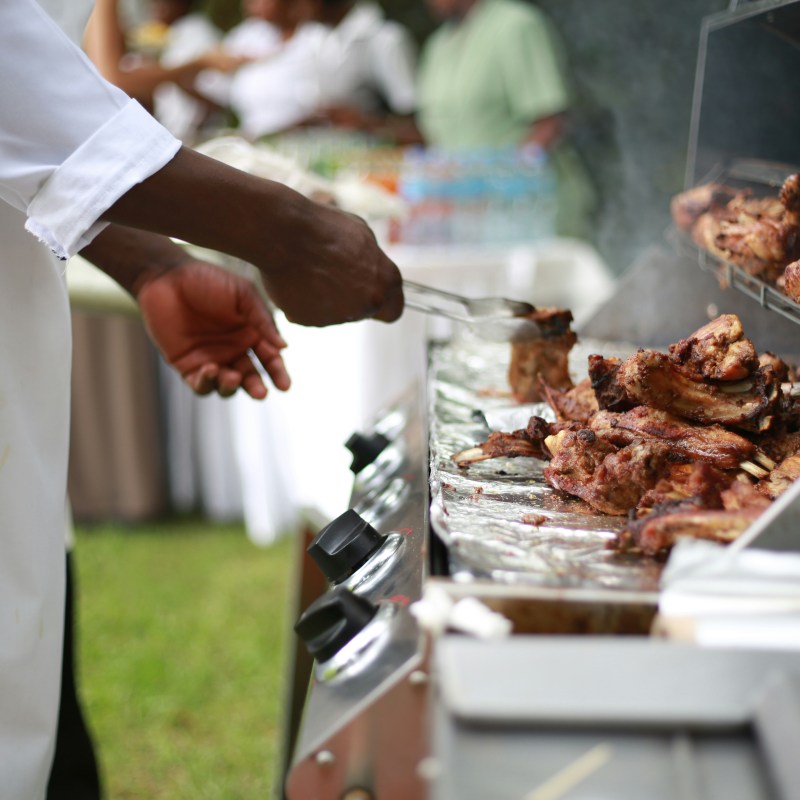
Barbecue culture runs deep in a handful of US states.
Videos by TravelAwaits
While Americans far and wide enjoy a sticky-sweet rack of ribs, a few states lay claim to the ‘best’ barbecue. Even within state or city lines, debates might rage about which restaurants and smokehouses do it best.
All the hype makes sense. Barbecue is an American pastime—one that has its origin in a variety of places.
For example, before Europeans arrived, tribes like the Taino and Miskito were fans of slow-cooking meat over indirect heat. That tradition quickly spread and evolved.
Then skills like slow-cooking and braising methods were brought over by African Americans. Europeans at the time were skilled in basting, a method that had traditionally been used to seal in flavor while cooking at high heat.
Toss these influences together and you have the basic formula for good barbecue.
But there’s one more secret American ingredient: high-quality red meat.
Starting in the mid-1800s, the US invested heavily in its beef industry. And if you follow the trail of cattle driving, meat packing, and train shipments from the late 1800s and early 1900s, you might notice a pattern.
Here’s how it went: cattle were raised and driven north from Texas to the stockyards and abattoirs of Kansas and Missouri before being packed and shipped east to places like Tennessee, Kentucky, and the Carolinas.
And there you have it: the Barbecue Belt, a remnant from the US’s glorious cattle-driving heyday.
But which regions, cities, and restaurants do it best?
Austin, Texas
What makes barbecue different here: It’s all about the quality and freshness of meat in Austin. Locals tend to season their meats with salt and pepper, then slow-cook them over oak wood. That creates some seriously smoky flavor, which is made even more savory by black-crackled brisket slabs. Simple and delicious.
Where to eat:
Dallas, Texas
What makes barbecue different here: In Dallas, locals prefer hickory wood for their barbecue pyres. There’s also a stronger focus on sweet-and-tangy sauces, similar to those preferred in Kansas City. Like Austin, there’s also a good amount of pork sausage, known as hot links in Dallas (and hot guts in Austin, unfortunately).
Where to eat:
Saint Louis, Missouri
What makes barbecue different here: Compared to other barbecue-centric cities, locals in St. Louis love to grill their meats. And they’ve got a serious love of ribs, pig snout, and pig ears. Here, the barbecue sauce isn’t quite as sweet as KC’s because the base is made from vinegar instead of molasses. As in Dallas, most barbecue is made using hickory wood.
Where to eat:
Kansas City, Missouri
What makes barbecue different here: Those who didn’t grow up in barbecue hotspots might list Kansas City as the capital of barbecue—and it wouldn’t be a poor approximation. This city regularly gets name-dropped around the world for its slow-cooked meats. Locals like their sauce sweet and extremely thick, usually made from molasses and tomatoes. Oh, and they’ll will slow-cook anything—from chicken to turkey to ribs. In KC, barbecue isn’t a high-class affair; one of the city’s best bbq haunts is located inside a gas station.
Where to eat:
Memphis, Tennessee
What makes barbecue different here: Pork is a big deal in Memphis barbecue, but the sauce is what really stands out. It’s all about dry ribs here—nothing like the hefty, coagulated sauces in Kansas City. Dry rub is typically a blend of paprika, cayenne, black pepper, and garlic and onion. Oh, and Memphis is known for its other barbecue oddities, including its barbecue bologna and spaghetti. (Mamma mia…)
Where to eat:
Lexington, North Carolina
What makes barbecue different here: Pork shoulder is the king of Lexington barbecue. Locals like to eat it chopped or sliced—so long as it’s still juicy, sweet, and covered in Lexington’s ketchup-vinegar sauce. You’ll also see offers for ‘outside brown’ on the menu, which is also common in Saint Louis (called ‘burnt ends’). Outside brown refers to the crunchy and caramelized bits left after a good smoking. (This is the stuff you’d sell your soul for.)
Where to eat:
